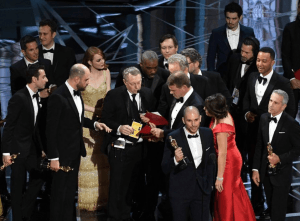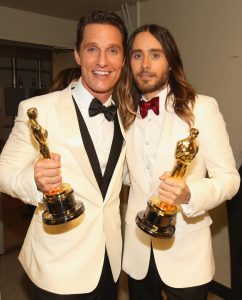The Art of Academy Award Campaigning
Published on February 10, 2020, at 10:40 p.m.
by Hannah Taylor.
It’s Feb. 26, 2017, and the 89th Academy Awards are coming to a close. “And the Academy Award … for Best Picture,” Warren Beatty starts hesitantly. An exasperated Faye Dunaway says, “Come on!” and proceeds to announce “La La Land” as the winner of the night’s biggest prize. Cheers rise from the crowd. The cast and crew of the movie musical gather on the Dolby Theatre’s stage and begin to thank their loved ones.
Then, a man with a headset and red envelope enters the frame. Joyful faces turn confused, then shocked. Producer Jordan Horowitz steps back up to the mic and utters the now famous line that will go down in Oscar history: “There’s a mistake. ‘Moonlight,’ you guys won best picture.”

This shocking mixup at the 2017 Oscars now lives in infamy, and for good reason. Anyone acquainted with the film industry knows the Oscars are the ultimate recognition of exceptional artistry and talent. For filmmakers, the awards are the apex of a lifetime of dedication to honing a craft, and for film studios, they mark the end of months spent campaigning for the awards.
Campaigning for the Academy Awards is more than just a comprehensive process that takes years to skillfully master; it’s an art that elevates the year’s best achievements in filmmaking.
The history of Oscar campaigning
While it would be hard to pinpoint the exact time in history that Academy Award campaigning began, “we do know that magazine ads increased exponentially starting in 1946,” Glenda Cantrell, University of Alabama associate professor emeritus, said. Cantrell said she spent “the last 10 years studying the Oscars and teaching classes in movie marketing and on the history of the Oscars.”
Variety reported that the earliest use of the word “consideration” (For Your Consideration, or FYC) began in 1948. Today, this phrase is the omnipresent heading on ads for Academy Award campaigns, and there’s a reason for this.
“The Academy has very definite rules about Oscar campaigns and they are enforced,” Cantrell said. “You can’t talk negatively about another movie or performer, you cannot ask for votes, and you cannot single out individuals or small groups to ‘court.’ That’s why Academy ads say ‘For Your Consideration’ — they can’t specifically ask for a vote.”
Though the heavy use of Oscar ads began in the 1940s, some suggest the current, multifaceted form of Oscar campaigning started in 1998 with Miramax’s fierce campaign for “Shakespeare in Love.” Nominated for 13 Oscars, it won seven, including best actress in a leading role and, in a dramatic upset over “Saving Private Ryan,” best picture.
Regardless of when Oscar campaigning really began, Cantrell noted that “campaigns haven’t changed much over the years, except that the amount of money spent has increased dramatically.”
The makeup of an Oscar campaign
Those who follow entertainment trade publications will notice the mass amounts of FYC ads every winter, but much of Oscar campaigning takes place away from the public’s eye.
“A lot of our campaigning in the initial stages [pre-nomination] is on the personal front, talking to members and letting them know what our slate looks like,” Joshua Jason, owner of Joshua Jason Public Relations, (JJPR) said. “If the budget permits we often back this up with a screening and reception so these voters can meet the filmmakers. I always find that regardless of topic and category the human connection between a filmmaker and the voter is important.”
Jason started his PR agency 17 years ago from his living room. He has since worked on big studio campaigns like those for “BlacKkKlansman” and “The Shape of Water” (2018 best picture winner), as well as smaller campaigns for international films and animated shorts.
“I find that I work more on the smaller campaigns … because you have very little money to play with,” Jason said. “You have to focus on journalists that really enjoy this kind of material [international films and animated shorts] and on voters that will show up to meet these [filmmakers].”
Campaigns Jason worked on this year garnered nominations for best actress (Cynthia Erivo, “Harriet”), best original song (“Stand Up” from “Harriet”) and an Oscar win for best live action short film (“The Neighbors’ Window”).
As for tangible distribution materials, Cantrell said, “Full-color brochures are the mainstay of the current campaigns. Whereas campaigns for actors tend to focus on print ads in trade magazines and personal appearances with Academy members, campaigns for the crafts focus on the execution of their technical or artistic skills within the movie.”
The timeline of an Oscar campaign
Before an Oscar campaign starts, the studio or distributor has to select which films to campaign for.
“Studios/distributors select films for potential Oscar campaigns for many different reasons; the decision can be based on their pedigree (actor, director, etc.), or genre, or superior application of crafts, and/or any ‘buzz’ surrounding the film,” Daniel Wheatcroft, CEO of Shoot to Thrill Productions LLC, said.
Wheatcroft is a 35-year veteran of the entertainment industry and “worked on at least 25 campaigns during (his) time at Universal Pictures,” he said. “Some of the key campaigns were ‘Schindler’s List,’ ‘Apollo 13,’ ‘Fried Green Tomatoes,’ ‘Field of Dreams,’ ‘Jurassic Park,’ ‘Backdraft’ and ‘Back to the Future.’”
“The most challenging part of a campaign, however, comes before the nominations,” he said, going on to detail the strategic planning process.
“Since nominations are made by the individual branches, you have to create a plan and a budget around the film’s possibilities,” he explained. “For example, do you send costume-specific mailers to the Costume Branch? Do you market the talent to the Acting Branch? Was there a technological advancement that you can market directly to the Sound Branch or the Visual Effects Branch or the Editing Branch? With 17 branches, there are a lot of decisions to make. And, of course, if you feel that you have a potential ‘Best Picture,’ you have to market to the entire Academy.”
This process doesn’t happen overnight. Sara Vahabi, owner of Phase 2 Public Relations, said the typical Oscar campaign runs for about four-to-five months.
“We usually start prepping and planning during the early summer months, so that we are ready to hit the ground running in early September,” she said.
Most acknowledge the start of awards season with film festivals Telluride, TIFF and Venice in late August and early September, as they “premiere a large number of potential awards contenders,” Vahabi said.
After the film festival cycle, the campaigning process is broken into two phases: phase one and phase two. Phase one is before nominations are announced, and phase two is after.
“After nominations — depending on which nominations are received — a budget is determined as to what support should be provided to the film,” Daniel Wheatcroft of Shoot to Thrill Productions said. “There is a lot you can’t do, per Academy rules, so you have to be creative in the way you approach ads, ad placement, brochures, personal appearance screenings, DVDs of the film, ‘The Making of …’ craft-specific DVDs for specific branches, etc.”
Jason said the big shift happens in phase two. “In phase one, you’re allowed to campaign by having screenings and reception. … The big difference in phase two is that you’re no longer allowed to host parties of any kind,” he said.
Creating narratives around a film
The most crucial part of any campaign is getting the film’s story straight.
“It’s important to establish a central narrative early on, so that you then can create a cohesive and well-rounded campaign across all marketing and publicity platforms,” Vahabi said. She noted the importance of connecting a film to the “zeitgeist” of the current times.
“One of my favorite campaigns was for the film ‘Loving,’ the story of Richard and Mildred Loving, a couple whose arrest for interracial marriage in 1960s Virginia began a legal battle that would end with the Supreme Court’s historic 1967 decision,” Vahabi said. “It came out during the 2016 elections, and we collaborated with the ACLU in California for a number of screenings that really brought home the message of how important it is to not give up hope and keep up the good fight.”

In 2013, Vahabi worked on the Oscar campaign for “Dallas Buyers Club.” “The story was raw and real, and the actors truly gave everything to the roles, and all of that really struck a chord with the audience,” she said. “From a pure Oscar campaign perspective, we really pushed the acting categories for this campaign as we knew that the power of the performances would push the campaign forward.”
Clearly, this strategy paid off. Matthew McConaughey and Jared Leto won best actor and best supporting actor, respectively, for their performances in the film. This was only the fifth time in Oscar history that these two awards went to actors from the same movie.
Jason said that in addition to crafting narratives based on the film’s subject, much of his messaging comes across through enthusiasm.
“I really get behind my movies. … If you can’t tell the truth, it comes across,” he said.
Why do Oscar campaigns matter?
After winning best picture at the 2017 Academy Awards, “Moonlight” earned an additional $2.5 million at the box office. This is not an uncommon trend. Among the 2020 Oscar best picture nomination box office bumps, Deadline estimated that Sam Mendes’ war drama “1917” would see an $82 million increase in ticket sales by Oscar night.
However, money aside, the Oscars ultimately allow movies to reach wider audiences, elevating the stories of filmmakers. They expand the possibility of change, and give way to the hope that the voice of a few will resonate with the lives of millions.
“To win Best Picture after a concerted campaign is a celebration for all of those who worked on the picture and for all those who presented the campaign,” Wheatcroft said. “It is an electric feeling that lives in a moment in time.”




